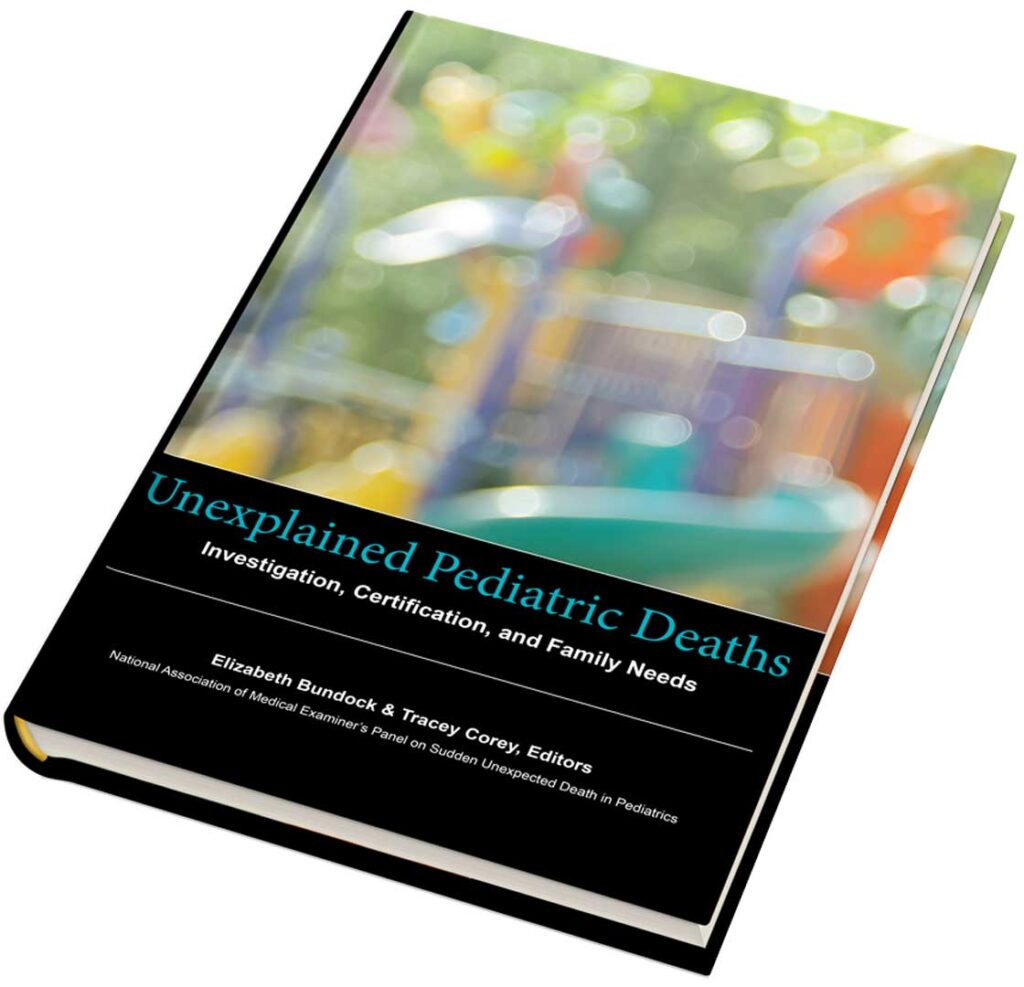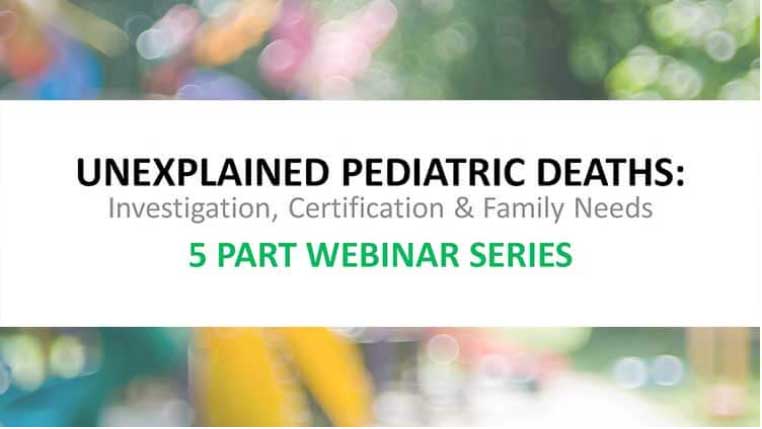
Investigation, Certification
& Family Needs

Order Your Copy Today

Unexplained Pediatric Deaths: Investigation, Certification and Family Needs
$150.00
Procedural guidance and key considerations developed by the National Association of Medical Examiners Panel on Sudden Unexpected Death in Pediatrics. This 340 page publication reviews medicolegal investigation of sudden, unexpected pediatric deaths, focusing on systems and procedures in the United States and those deaths which remain incompletely understood or entirely unexplained. It discusses the evolution of our understanding and practice in the area of sudden, unexpected pediatric death investigation, covering the changing philosophies and medical theories as to causation and changing investigative and certification strategies. Procedural guidance for investigation, autopsy and ancillary testing, certification and reporting, and key considerations for prevention, research and working with family members and other professional team members are provided.
– Professor Ryan Blumenthal MBChB (Pret), MMed (Med Forens) Pret, FC For Path (SA) Dip For Med (SA) PhD (Wits)
Senior specialist forensic pathologist at the University of Pretoria’s Department of Forensic Medicine, South Africa.
About the Book
This publication reviews medicolegal investigation of sudden, unexpected pediatric deaths, focusing on systems and procedures in the United States and those deaths which remain incompletely understood or entirely unexplained. It discusses the evolution of our understanding and practice in the area of sudden, unexpected pediatric death investigation, covering the changing philosophies and medical theories as to causation and changing investigative and certification strategies. Procedural guidance for investigation, autopsy and ancillary testing, certification and reporting, and key considerations for prevention, research and working with family members and other professional team members are provided.
The path to production of this publication began in 2016 when the National Association of Medical Examiners received a scientific grant from the SUDC Foundation called “Sudden Death in Pediatrics: Consensus for Investigation, Certification, Research Direction and Family Needs” to convene, in collaboration with the American Academy of Pediatrics, an expert panel to identify and discuss the diverse issues and limitations surrounding these deaths and build a foundation for national consensus. The combined effort of a panel of medical examiners, pediatricians, and federal agency representatives, representing the diverse interests of death investigation, autopsy performance, certification, clinical subspecialties (pediatrics, neurology, cardiology, child abuse, injury prevention, infectious diseases, genetics, and metabolic diseases), family needs, prevention, and epidemiology, culminated in this publication.
The full text is now available for open access on the NCBI bookshelf and searchable on PubMed.
No-Cost On-Demand 5-Part Webinar
Over the last year, the SUDC Foundation has worked on a comprehensive webinar to support further training on the procedural guidance from the our text, Unexplained Pediatric Deaths: Investigation, Certification and Family Needs. Across 6 hours of training, didactic lecture format and simulated videos are utilized to help train the participant. Many thanks to the professionals who played their authentic professional selves in these dramatic videos alongside live actors playing acutely bereaved parents. The 5-part series is now available through our website.
Resources
Topics
Historical Perspectives
A review of the changing perceptions, philosophies, medical theories, and investigative and prevention initiatives through the centuries.
Risk Factors & Prevention
A review of the latest evidence regarding risk factors and prevention strategies for sudden, unexpected pediatric deaths, including genetic, metabolic, and cardiac evaluation for higher risk children.
Death Certification & Surveillance
A review of death certification, classification and coding, with procedural guidance for the medical examiner/coroner regarding cause and manner of death opinions.
Medicolegal Death Investigation
Procedural guidance for the medicolegal death investigator regarding scene investigation strategies, doll reenactment for infant and early childhood deaths, collection of pertinent circumstance and historical data, proper documentation.
Family Needs & Professional Relations
Strategies to help professionals recognize the many needs of family members grieving while a thorough death investigation is conducted and addressing those needs with compassionate support. An examination of various professional roles in a child death investigation and key considerations for successful interprofessional relations.
Research Needs
An overview of the research needs created by our gaps in knowledge of causation, limitations of diagnostic testing, heterogeneity in reporting, and shifting epidemiology.
Autopsy & Ancillary Testing
Procedural guidance for the forensic pathologist regarding information needed prior to the autopsy; specific dissections, examinations, and techniques; radiology studies; microbiology, toxicology, chemical analysis, metabolic screening, and other ancillary testing; genetic/molecular testing; biospecimen retention; pathology subspecialist consultations; quality assurance procedures; synoptic reporting; and communications before and after the autopsy with other professionals, agencies, and the family of the child.
Contributors
Editors
Elizabeth A. Bundock MD, PhD
Co-Chair and Editor
Deputy Chief Medical Examiner
Office of the Chief Medical Examiner
Burlington, VT
Tracey S. Corey MD
Co-Chair and Editor
Associate Medical Examiner
Florida Districts 5 & 24
Assistant Editors
Thomas A. Andrew MD, FCAP, FAAP
Laura Gould Crandall MA
Eric A. Eason MD
Wendy M. Gunther MD
Rachel Y. Moon MD
Vincent J. Palusci MD, MS, FAAP
Cynthia M. Schmidt MD, MLS
Mary Ann Sens MD, PhD
Authored by the National Association of Medical Examiner’s Panel on Sudden Unexpected Death in Pediatrics
Michael J. Ackerman MD, PhD
Windland Smith Rice Cardiovascular Genomics Research Professor
Professor of Medicine, Pediatrics, and Pharmacology, Mayo Clinic College of Medicine and Science
Director, Genetic Heart Rhythm Clinic and the Mayo Clinic Windland Smith Rice Sudden Death Genomics Laboratory
President, Sudden Arrhythmia Death Syndromes (SADS) Foundation
Mayo Clinic
Thomas A. Andrew MD, FCAP, FAAP
White Mountain Forensic Consulting Services
Concord, NH
Isabel Barata MS, MD, MBA, FACP, FAAP, FACEP
Associate Professor of Pediatrics and Emergency Medicine,
Donald and Barbara Zucker School of Medicine at Hofstra/Northwell
Hempstead, NY
Pediatric Emergency Medicine Service Line Quality Director,
Emergency Medicine and Pediatrics Service Line;
New Hyde Park, NY
Director of Pediatric Emergency Medicine,
North Shore University Hospital
Manhasset, NY
Susan A. Berry MD, FACMG, FAAP
Professor and Director
Division of Genetics and Metabolism
Departments of Pediatrics and Genetics, Cell Biology & Development
University of Minnesota
Erin Bowen MD
Griffin Hospital in Ansonia, CT;
Yale New Haven Children’s Hospital New Haven, CT
Derek A. Bruce MB, ChB, FAANS, FAAP
Prof. Neurosurgery & Pediatrics
Center for Neuroscience & Behavioral Medicine
Children’s National Medical Center
Washington, DC
Elizabeth A. Bundock MD, PhD
Deputy Chief Medical Examiner
Office of the Chief Medical Examiner
Burlington, VT
Kristin M. Burns MD
Physician
Heart Development and Structural Diseases Branch/Division of Cardiovascular Sciences
National Heart, Lung, and Blood Institute/National Institutes of Health
Rudolph J. Castellani MD
Department of Pathology, Anatomy and Laboratory Medicine; Rockefeller Neuroscience Institute;
West Virginia University School of Medicine, Morgantown, WV
Tracey S. Corey MD
Associate Medical Examiner
Florida Districts 5 & 24
Laura Gould Crandall PT, MA
Research Scientist, Department of Neurology, NYU Langone Health, New York, NY
President and Co-founder, The SUDC Foundation, Roseland, NJ
Orrin Devinsky MD
Professor, Department of Neurology
NYU Langone, New York, NY
Director NYU Langone Comprehensive Epilepsy Center
Stacy A. Drake PhD, MPH, RN
Associate Professor
Center for Excellent in Forensic Nursing
Texas A&M University
Eric A. Eason MD
Assistant Medical Examiner
Cook County Medical Examiner’s Office
Chicago, IL
Wendy M. Gunther MD
Assistant Chief Medical Examiner
Office of the Chief Medical Examiner
Commonwealth of Virginia Tidewater District
Amanda J. Kay MD, MPH, FAAP
Medical Director
Wilmington Primary Care Pediatric Practice
Christiana Care Health System
Laura D. Knight MD
Chief Medical Examiner and Coroner, Washoe County Regional Medical Examiner’s Office,
Reno, NV;
Associate Professor, Departments of Pathology and Pediatrics, University of Nevada Reno School of Medicine,
Reno, NV
Kristen Landi MD
Medical Examiner
Office of the Chief Medical Examiner of the City of New York
New York, NY
Kelly C. Lear MD
Coroner/Forensic Pathologist
Arapahoe County Coroner’s Office
Centennial, CO
Adele Lewis MD
Deputy State Chief Medical Examiner
Nashville, TN
Evan W. Matshes MD, FRCPC
NAA Group LLC
San Diego, CA
Brandi McCleskey MD
Assistant Professor, Department of Pathology, University of Alabama at Birmingham
Birmingham, AL;
Associate Coroner/Medical Examiner at Jefferson County Coroner/Medical Examiner’s Office
Birmingham, AL
Rachel Y. Moon MD
Division Head, General Pediatrics
Professor of Pediatrics
University of Virginia School of Medicine
Vincent J. Palusci MD, MS, FAAP
Professor of Pediatrics
NYU School of Medicine
New York, NY
Kathryn Pinneri MD
Montgomery County Forensic Services
Conroe, TX
Cynthia M. Schmidt MD, MLS
Associate Professor
Education & Research Services
McGoogan Library of Medicine
University of Nebraska Medical Center
Mary Ann Sens MD, PhD
Professor and Chair of Pathology
University of North Dakota School of Medicine and Health Sciences
Carrie K. Shapiro-Mendoza PhD, MPH
Chief, Field Support Branch
Division of Reproductive Health
National Center for Chronic Disease Prevention and Health Promotion
Centers for Disease Control and Prevention
Jane W. Turner MD, PhD
Virchow Consulting Services
St. Louis, MO
Margaret Warner PhD
Mortality Statistics Branch, Division of Vital Statistics
National Center for Health Statistics
Centers for Disease Control and Prevention Steven M. White MD, PhD
Lead Forensic Pathologist
British Columbia Coroner’s Service
Vancouver, BC
Canada
Nori Williams MS, CGC
Genetic Counselor
Molecular Genetics Laboratory
The City of New York Office of Chief Medical Examiner,
New York, NY

